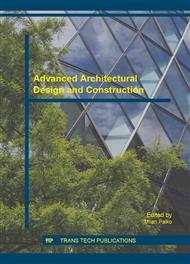p.115
p.121
p.127
p.133
p.139
p.146
p.152
p.159
p.165
Thermal Bridges Impact on Energy Need for Heating in Low Energy Wooden House
Abstract:
Energy need for heating is depend on the heat loss of the builing. It is essential to minimize heat losses when designing and building energy efficient buildings. For an energy-efficient building in a cold climate, a large part of the space heating demand is caused by transmission losses through the building envelope. The low-energy buildings are enevelope construction with high thermal resistance. The impact of thermal bridges was studied by comparative calculations for a case study building with different amounts of insulation. In the low-energy buildings are envelope construction with high thermal resistance. When more insulation is used the relative impact of thermal bridges increases. In these buildings is necessary to specify each thermal bridges. This thesis deals with the influence of thermal bridges on energy need for heating in low energy wooden houses.
Info:
Periodical:
Pages:
139-145
Citation:
Online since:
January 2016
Authors:
Price:
Сopyright:
© 2016 Trans Tech Publications Ltd. All Rights Reserved
Share:
Citation:


